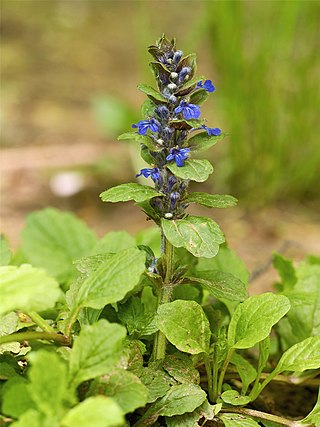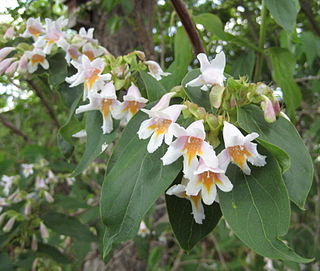
Abelia is a genus of flowering plants in the honeysuckle family, Caprifoliaceae. The genus currently includes six species native to China, Taiwan, and Vietnam.

Pieris is a genus of seven species of shrubs in the flowering plant family Ericaceae, native to mountain regions of eastern and southern Asia, eastern North America and Cuba. Known commonly in North America as andromedas or fetterbushes, they are broad-leaved evergreen shrubs growing to 1–6 metres tall and 3–10 ft (0.9–3.0 m) wide. The leaves are spirally arranged, often appearing to be in whorls at the end of each shoot with bare stretches of shoot below; they are lanceolate-ovate, 2–10 cm (0.8–3.9 in) long and 1.0–3.5 cm (0.4–1.4 in) broad, leathery textured, and with an entire or serrated margin. The young leaves in spring are typically brightly coloured. The flowers, which may have a very appealing honey scent, are bell-shaped, 5–15 mm (0.2–0.6 in) long, white or pink, and arranged in racemes 5–12 cm (2.0–4.7 in) long. The fruit is a woody capsule which splits into five sections to release the numerous small seeds.

Bergenia is a genus of ten species of flowering plants in the family Saxifragaceae, native to central Asia, from Afghanistan to China and the Himalayan region.

Ajuga, also known as bugleweed, ground pine, carpet bugle, or just bugle, is a genus of flowering plants in the Ajugeae tribe of the mint family Lamiaceae. There are over 60 species of annual or perennial, mostly herbaceous plants. They are native to Europe, Asia, Africa, and Australia.

Dasiphora fruticosa is a species of hardy deciduous flowering shrub in the family Rosaceae, native to the cool temperate and subarctic regions of the northern hemisphere, often growing at high altitudes in mountains. Dasiphora fruticosa is still widely referenced in the horticultural literature under its synonym Potentilla fruticosa. Common names include shrubby cinquefoil, golden hardhack, bush cinquefoil, shrubby five-finger, widdy, kuril tea and tundra rose.

Gaultheria is a genus of about 283 species of shrubs in the family Ericaceae. The name commemorates Jean François Gaultier of Quebec, an honour bestowed by the Scandinavian Pehr Kalm in 1748 and taken up by Carl Linnaeus in his Species Plantarum. These plants are native to Asia, Australasia and North and South America. In the past, the Southern Hemisphere species were often treated as the separate genus Pernettya, but no consistent reliable morphological or genetic differences support recognition of two genera, and they are now united in the single genus Gaultheria.

Cotoneaster franchetii is a species of Cotoneaster native to southwestern China, in the provinces of Guizhou, Sichuan, Tibet, and Yunnan, and also in adjacent northern Myanmar and northern Thailand.

Aletris, the colicroot, colicweed, crow corn, or unicorn root, is a genus of flowering plants in the family Nartheciaceae, native to North America and to eastern and southeastern Asia, especially China. It was used as a component in Lydia Pinkham's original Vegetable Compound.

Eriocapitella hupehensis, a species of flowering plant in the buttercup family Ranunculaceae, is native to Asia. The specific epithet hupehensis, which means "from Hupeh province, China", refers to a region where the species is known to occur. In Chinese, it is called dǎ pò wǎn huā huā (打破碗花花), which means "broken bowl flower".

Lespedeza thunbergii is a species of flowering plant in the legume family known by the common names Thunberg's bushclover, Thunberg's lespedeza, and shrub lespedeza. It is native to the eastern Himalayas, China, Korea, and Japan.

Roscoea wardii is a perennial herbaceous plant occurring from eastern Arunachal Pradesh in India to western Yunnan in China. Most members of the ginger family (Zingiberaceae), to which it belongs, are tropical, but like other species of Roscoea, R. wardii grows in much colder mountainous regions.

Vesalea floribunda, also known as Mexican abelia, is a species of flowering plant in the honeysuckle family, Caprifoliaceae. It is a shrub native to southern Mexico, ranging from central Veracruz to northern Oaxaca and southeastern Chiapas.

Dipelta floribunda, synonym Linnaea dipelta, is a species of deciduous shrub in the family Caprifoliaceae. It is native to central and east-central China. In late spring and early summer it produces masses of white trumpet-shaped flowers with orange throats.

Dipelta yunnanensis, synonym Linnaea yunnanensis, is a species of deciduous shrub belonging to the honeysuckle family, Caprifoliaceae. It is native to southeastern Tibet, Yunnan Province of south-central China, and northern Myanmar.

Rhododendron calostrotum is a species of flowering plant in the genus Rhododendron native to Tibet, south-central China, and Myanmar. Its putative subspecies Rhododendron calostrotum subsp. keleticum, called the beautiful-covering rhododendron, and its cultivar 'Gigha' have both gained the Royal Horticultural Society's Award of Garden Merit.

Rhododendron edgeworthii, the Edgeworth rhododendron, is a species of flowering plant in the genus Rhododendron native to the eastern Himalaya, south-central China, Tibet, and Myanmar. It has gained the Royal Horticultural Society's Award of Garden Merit.

Euonymus cornutus is a species of flowering plant in the genus Euonymus, native to Tibet, central China and Myanmar. Its putative variety Euonymus cornutus var. quinquecornutus, called the five‑horned spindle, has gained the Royal Horticultural Society's Award of Garden Merit.

Eriocapitella is a genus of flowering plants in the buttercup family Ranunculaceae. Plants of the genus are native to Asia. The generic name Eriocapitella roughly translates to "growing in a small woolly head", which refers to the hairy ovary and fruit of some members of the genus. Cultivated plants are commonly known as fall-blooming anemones.

Euphorbia sikkimensis, called the Sikkim spurge, is a species of flowering plant in the genus Euphorbia, native to Nepal, the eastern Himalayas, Tibet, south-central and southeast China, Myanmar, and Vietnam. It grows in alpine meadows, sparse forests, and scrub. It has gained the Royal Horticultural Society's Award of Garden Merit.

Bergenia purpurascens, the purple bergenia, is a species of flowering plant in the family Saxifragaceae. It is a perennial herb and is native to Nepal, the eastern Himalayas, Assam, Tibet, south-central China, and Myanmar. The species, its putative variety Bergenia purpurascens var. delavayi, and its cultivar 'Irish Crimson' have all gained the Royal Horticultural Society's Award of Garden Merit. A useful feature in the garden is the visual interest that its foliage provides by turning a deep beet red during the winter. The Latin specific epithet purpurascens is in reference to the foliage that is purple in color.




















